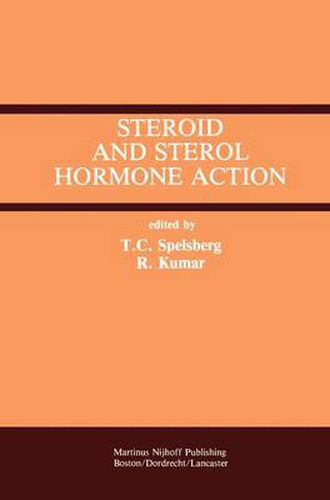Readings Newsletter
Become a Readings Member to make your shopping experience even easier.
Sign in or sign up for free!
You’re not far away from qualifying for FREE standard shipping within Australia
You’ve qualified for FREE standard shipping within Australia
The cart is loading…






This title is printed to order. This book may have been self-published. If so, we cannot guarantee the quality of the content. In the main most books will have gone through the editing process however some may not. We therefore suggest that you be aware of this before ordering this book. If in doubt check either the author or publisher’s details as we are unable to accept any returns unless they are faulty. Please contact us if you have any questions.
The purpose of this book is to focus attention on recent developments in steroid and sterol hormone action. Many authors have generously contributed to the book. As a result, there is a great diversity of opinion! A majority of the chapters deal with steroid or sterol hormone receptors. This is not meant to imply that receptor-mediated mechanisms are the sole or even the most important mechanisms by which steroid hormones act in the cell. There is wealth of evidence showing that other, non-receptor events, are important also. Steroid hormone recep tor research and the study of nuclear events mediated by steroids are presently the most intensely studied aspects of sterol hormone action and our selection of topics reflects this trend. We have also included chapters on vitamin 0 sterols and thyroid hormone in the book, as there is pood evidence that these hormones act in a manner similar to other classical steroids. 1 IMMUNOCHARACTERIZATION OF THE NUCLEAR ACCEPTOR SITES FOR THE AVIAN OVIDUCT PROGESTERONE RECEPTOR A. GOLDBERGER, M. HORTON, T. C. SPELSBERG Department of Biochemistry and Molecular Biology, Mayo Clinic and Mayo Graduate School of Medicine, Rochester, MN 55905 INTRODUCTION It is well known that steroid hormones, certain vitamins and sterols, enter target cells and bind to specific protein receptors in the cyto plasm or nucleus (1-4). This binding is saturable, high affinity, and steroid specific.
$9.00 standard shipping within Australia
FREE standard shipping within Australia for orders over $100.00
Express & International shipping calculated at checkout
This title is printed to order. This book may have been self-published. If so, we cannot guarantee the quality of the content. In the main most books will have gone through the editing process however some may not. We therefore suggest that you be aware of this before ordering this book. If in doubt check either the author or publisher’s details as we are unable to accept any returns unless they are faulty. Please contact us if you have any questions.
The purpose of this book is to focus attention on recent developments in steroid and sterol hormone action. Many authors have generously contributed to the book. As a result, there is a great diversity of opinion! A majority of the chapters deal with steroid or sterol hormone receptors. This is not meant to imply that receptor-mediated mechanisms are the sole or even the most important mechanisms by which steroid hormones act in the cell. There is wealth of evidence showing that other, non-receptor events, are important also. Steroid hormone recep tor research and the study of nuclear events mediated by steroids are presently the most intensely studied aspects of sterol hormone action and our selection of topics reflects this trend. We have also included chapters on vitamin 0 sterols and thyroid hormone in the book, as there is pood evidence that these hormones act in a manner similar to other classical steroids. 1 IMMUNOCHARACTERIZATION OF THE NUCLEAR ACCEPTOR SITES FOR THE AVIAN OVIDUCT PROGESTERONE RECEPTOR A. GOLDBERGER, M. HORTON, T. C. SPELSBERG Department of Biochemistry and Molecular Biology, Mayo Clinic and Mayo Graduate School of Medicine, Rochester, MN 55905 INTRODUCTION It is well known that steroid hormones, certain vitamins and sterols, enter target cells and bind to specific protein receptors in the cyto plasm or nucleus (1-4). This binding is saturable, high affinity, and steroid specific.